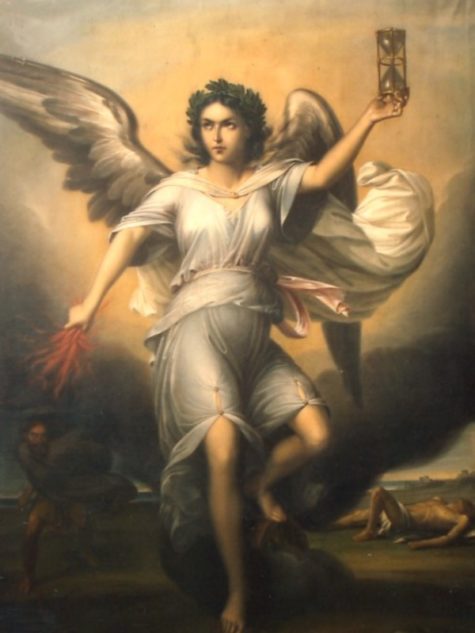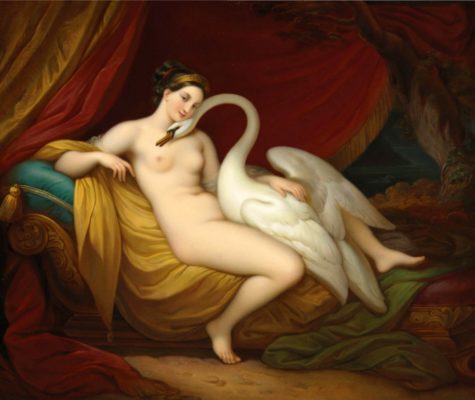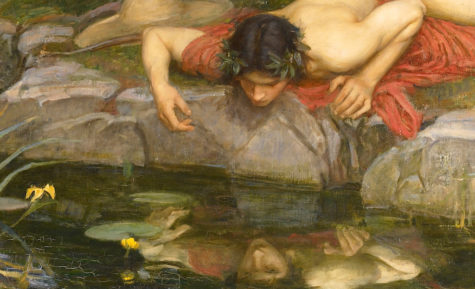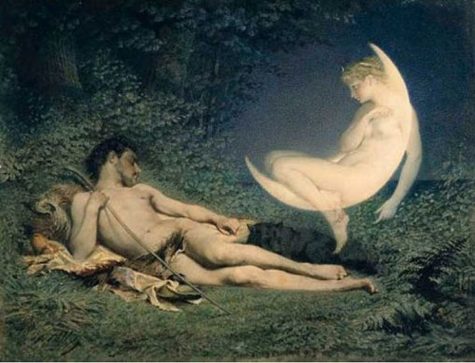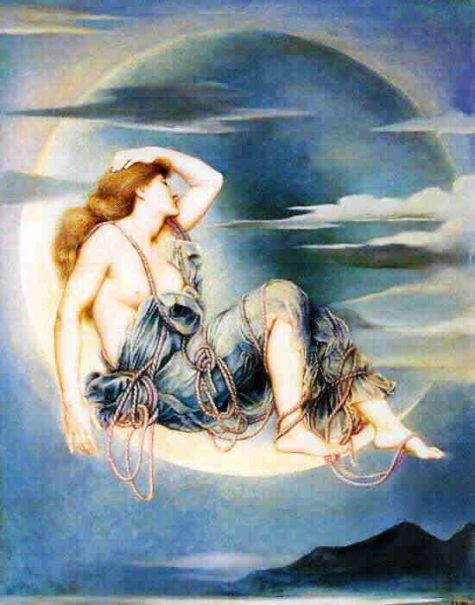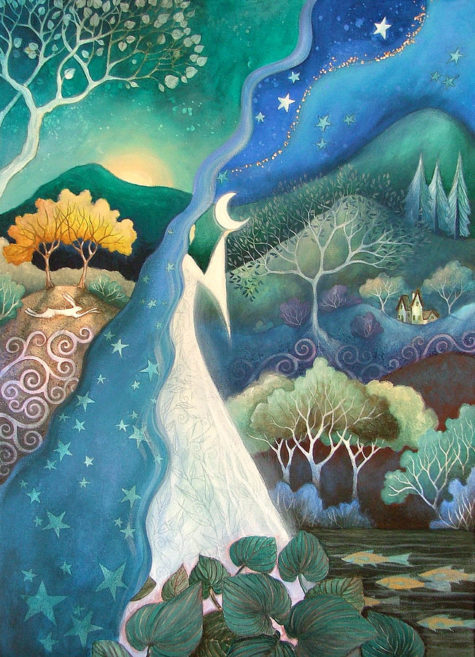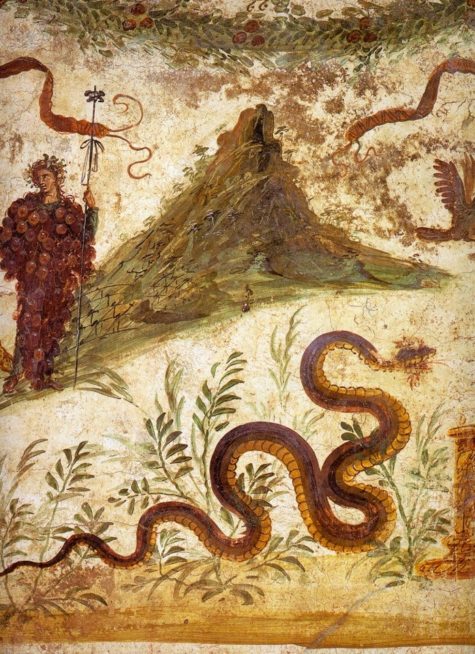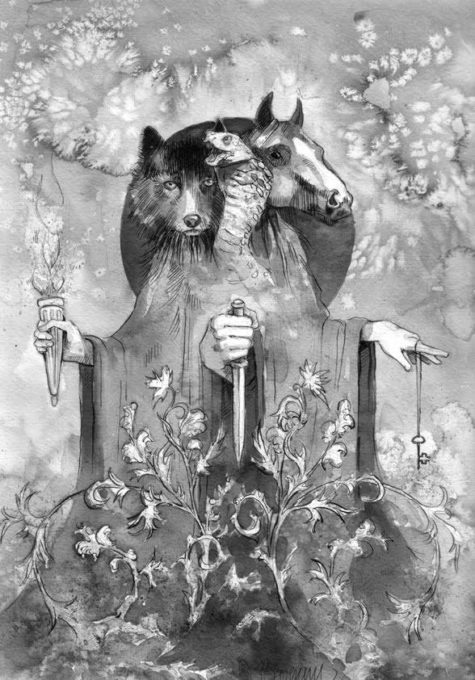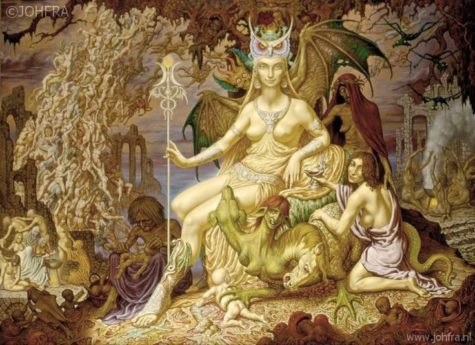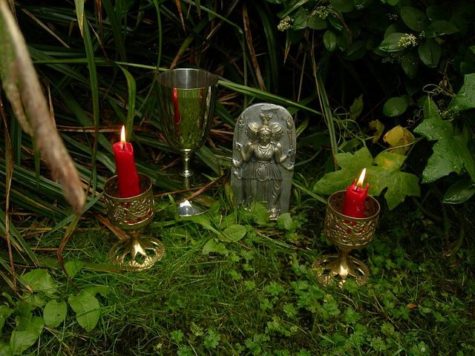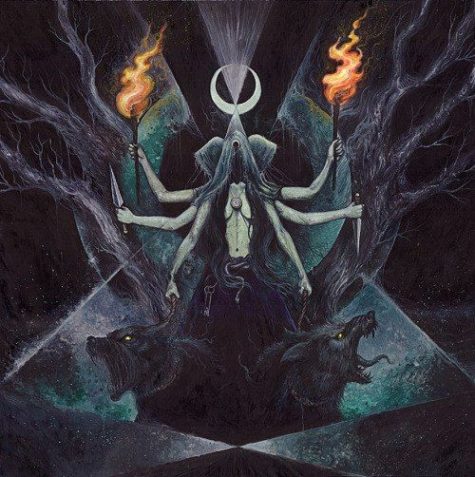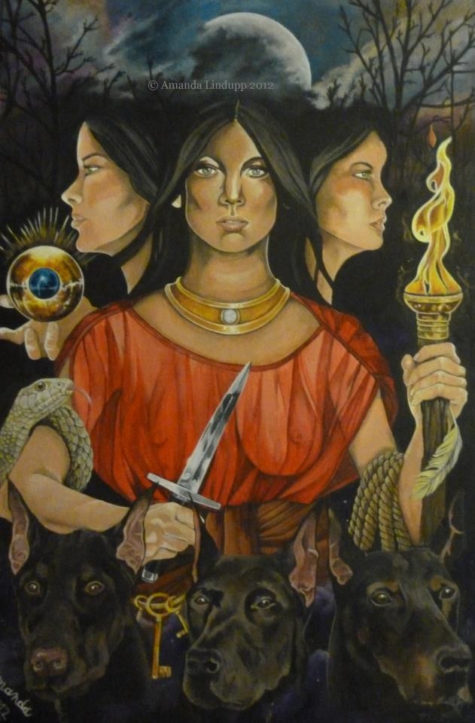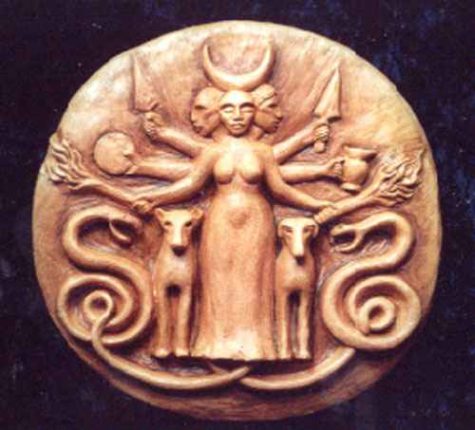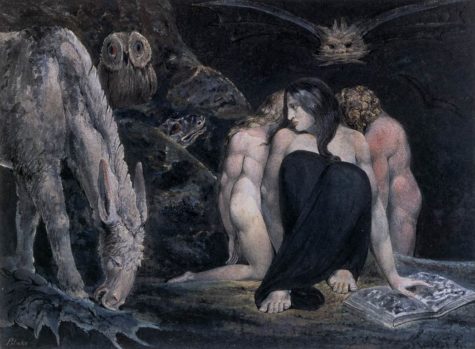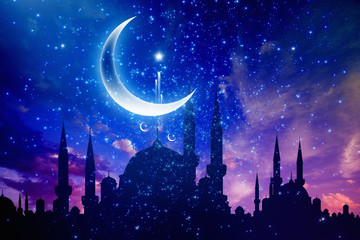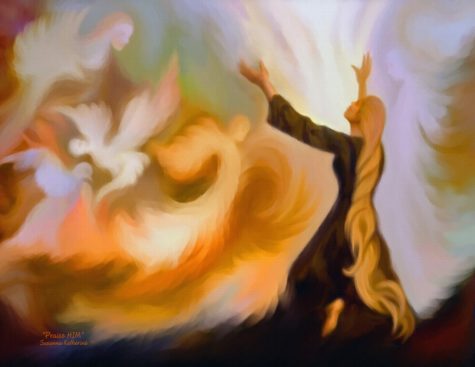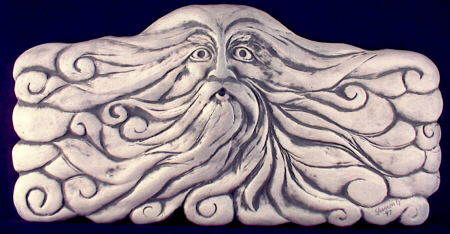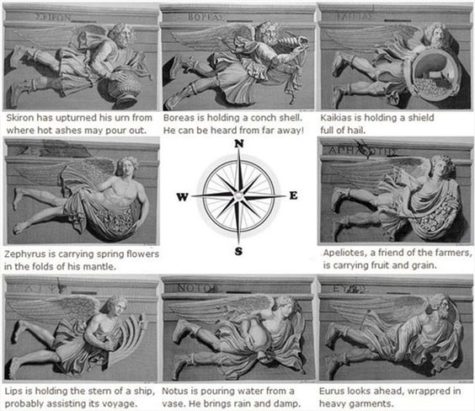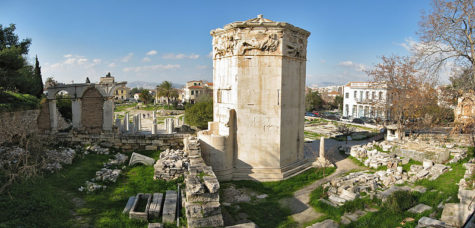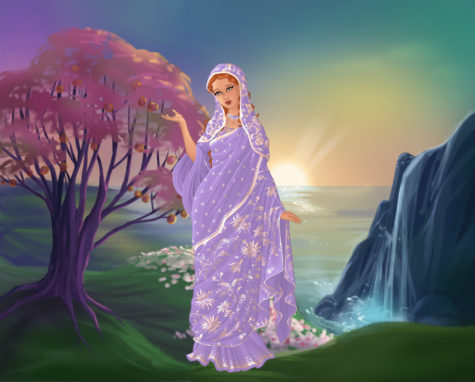Greek Gods and Goddesses
Winged Balancer of Life,
Dark-faced Goddess, Daughter of Justice
Nemesis is the Greek Goddess of balance, justice, retribution, and vengeance. Evil deeds, undeserved good fortune, and crimes that go unpunished or that bring rewards, may invoke Her wrath and remorseless justice and retribution.
Nemesis resembles modern images of angels. She is a winged, wreathed woman, usually dressed in white. She can also be seen as a Griffon holding a Wheel of Fortune. She is sometimes known as, Adrasteia, which means “The Inescapable.”
- Other Names: Rhamnousia, Rhamnusia, Adrasteia, Adrestia
- Plant: Mullein
- Creature: Griffin, Goose
- Festival: The Nemesia
- Symbols: The wheel, wings, whip or sword, dagger, measuring rod, hourglass, bridle, scales, branch laden with apples
Nemesis measures out happiness and unhappiness making sure that happiness does not occur excessively. If you are arrogant before the Gods, she will mete out the punishment. What goes around comes around and you can be sure that Nemesis will use Her powers against those who deserve it.
She is implacable and remorseless, but she is not cruel. Nemesis distributes just deserts. She is the spirit of righteous, justified anger, directing her powers against those who have violated cosmic order. Nemesis has broader jurisdiction than the Erinyes, who may be her sisters. While the Erinyes only avenge shed blood, Nemesis takes action wherever natural laws are flouted, broken, or disrespected.
Nemesis serves as a personal goddess offering protection and sponsorship to devotees. Those who invoke her protection are expected to behave honorably and to uphold natural moral code. You can find spells and rituals that invoke Nemesis in the Book of Shadows.
It is believed that Nemesis is the daughter of Nyx the dark Goddess of night and Erebus, God of the Underworld. Her closest companion is Aidos, the Goddess of Shame. Greek prophesies suggests that when humans become more wicked than good, Nemesis and Aidos will abandon the Earth and then all hell will break loose!
Nemesis hasn’t left yet and is still administering justice. German painter Alfred Rethel painted her as an avenging angel in hot pursuit in his 1837 painting, “Nemesis Pursuing a Murderer.” According to legend, a high-ranking man with secret, undiscovered crimes on his conscience won Rethel’s painting in a Frankfurt lottery. Contemplation of Nemesis’ portrait allegedly drove him mad.
Nemesis Stones
Nemesis Stones are stones taken from an altar of Nemesis. Stones are engraved with an image of Nemesis, usually in the form of a young woman standing with one foot on a wheel. They are worn as amulets around the neck and set into rings. They exorcise and ward off evil spirits as well as preventing and banishing nightmares and healing the moonstruck.
Spirit Allies:
Nemesis’ closest companion is Aidos, Goddess of Shame, and Artemis is Nemesis’ good friend. She may be worshiped together with Themis, Goddess of Divine Order. Nemesis is often found in the company of Tyche, Goddess of Fortune, if only to ensure that people get what they deserve.
Origins:
As the “Goddess of Rhamnous”, Nemesis was honored and placated in an archaic sanctuary in the isolated district of Rhamnous, in northeastern Attica. There she was a daughter of Oceanus, the primeval river-ocean that encircles the world.
Pausanias noted her iconic statue there. It included a crown of stags and little Nikes and was made by Pheidias after the Battle of Marathon (490 BC), crafted from a block of Parian marble brought by the overconfident Persians, who had intended to make a memorial stele after their expected victory. Her cult may have originated at Smyrna.
Nemesis and Helen of Troy
In some metaphysical mythology, Nemesis produced the egg from which hatched two sets of twins: Helen of Troy and Clytemnestra, and the Dioscuri, Castor and Pollux. While many myths indicate Zeus and Leda to be the parents of Helen of Troy, the author of the compilation of myth called Bibliotheke notes the possibility of Nemesis being the mother of Helen.
Nemesis, to avoid Zeus, turns into a goose, but he turns into a swan and mates with her. The story is as follows:
Rich-haired Nemesis gave birth to Helene when she had been joined in love with Zeus the king of the gods by harsh violence. For Nemesis tried to escape him and liked not to lie in love with her father Zeus the son of Kronos; for shame and indignation vexed her heart: therefore she fled him over the land and fruitless dark sea.
But Zeus ever pursued and longed in his heart to catch her. Now she took the form of a fish and sped over the waves of the loud-roaring sea, and now over Oceanus’ stream and the furthest bounds of Earth, and now she sped over the furrowed land, always turning into such dread creatures as the dry land nurtures, that she might escape him.
Nemesis, as she fled from Zeus’ embrace, took the form of a goose; whereupon Zeus as a swan had intercourse with her. From this union she laid an egg, which some herdsman found among the trees and handed over to Leda. She kept it in a box, and when Helene was hatched after the proper length of time, she reared her as her own. It is in this way that Leda comes to be the mother of Helen of Troy.
Here is a slightly different story, which also explains the creation of the Constellation Cygnus (or the Swan):
When Zeus, moved by desire, had begun to love Nemesis, and couldn’t persuade her to lie with him, he relieved his passion by the following plan. He bade Venus Aphrodite, in the form of an eagle, pursue him; he, changed to a swan, as if in flight from the eagle, took refuge with Nemesis and lighted in her lap. Nemesis did not thrust him away, but holding him in her arms, fell into a deep sleep.
While she slept, Zeus embraced her, and then flew away. Because he was seen by men flying high in the sky, they said he was put in the stars. To make this really true, Jupiter put the swan flying and the eagle pursuing in the sky. But Nemesis, as if wedded to the tribe of birds, when her months were ended, bore an egg. Hermes took it away and carried it to Sparta and threw it in Leda’s lap. From it sprang Helen, who excelled all other girls in beauty.
Nemesis and Narcissus
Although a respected goddess, Nemesis brought much sorrow to mortals such as Echo and Narcissus. Narcissus was a very beautiful and arrogant hunter from the territory of Thespiae and Boeotia, who disdained the ones who loved him.
Nemesis lured him to a pool where he saw his own reflection in the water and fell in love with it, not realizing it was only an image. He was unable to leave the beauty of his reflection and he eventually died. Nemesis believed that no one should ever have too much goodness in their lives, and she had always cursed those who were blessed with countless gifts.
Sources:
- Wikipedia
- Encyclopedia of Spirits
- Also known as: Mene (as in month or menstruation), and Latin Luna
- Origin: Greece
- Stones: Moonstones and Selenite (literally “moon rock”)
- Favored people: She is the matron of magicians, sorcerers, witches, and moon-gazers.
Selene is an ancient goddess of the moon. Comparatively little information regarding Selene’s veneration and rituals survives although she is described as “great in magic” and was apparently invoked in magic spells. Her parents are Titans, Hyperion and Theia. Helios, the sun, is her brother. Many of her functions were later transferred to Artemis as Helios’ were to Apollo.
Selene bathes in the ocean before riding up to the sky in her chariot every night, variously driven by a pair of white horses, bulls, or mules. She pulls the full moon across the sky. Alternatively she rides a horse sidesaddle. Sometimes Selene has to hide from a dragon, indicated by a lunar eclipse or absent moon. Or perhaps Selene is just making time with that dragon. Selene is an amorous goddess with many lovers including Pan and Zeus, with whom she had numerous children.
Her most famous love affair is with the young shepherd Endymion, the male sleeping beauty. Selene placed him under an eternal sleep spell so that his entire existence consisted of sleeping and making love to her. Selene spends her days in the Anatolian cave in which Endymion sleeps.
Selene’s name is etymologically related to a word meaning “light.” In her guise as the full moon, Selene sheds light on problems and mysteries.
- Manifestation:
Selene is the goddess of the moon, but she also is the moon. Selene may manifest as a woman or a cow, but you can also gaze at the moon and see her. As a woman, she is described as being very beautiful. She has wings and wears a diadem.
A scholarly article about the Goddess Selene:
Also called Mene, or Latin Luna, Selene was the goddess of the moon, or the moon personified into a divine being. She is called a daughter of Hyperion and Theia, and accordingly a sister of Helios and Eos; but others speak of her as a daughter of Hyperion by Euryphaessa, or of Pallas, or of Zeus and Latona, or lastly of Helios. She is also called Phoebe, as the sister of Phoebus, the god of the sun.
By Endymion, whom she loved, and whom she sent to sleep in order to kiss him, she became the mother of fifty daughters; by Zeus she became the mother of Pandeia, Ersa, and Nemea . Pan also is said to have had connection with her in the shape of a white ram.
Selene is described as a very beautiful goddess, with long wings and a golden diadem, and Aeschylus calls her the eye of night. She rode, like her brother Helios, across the heavens in a chariot drawn by two white horses, cows, or mules. She was represented on the pedestal of the throne of Zeus at Olympia, riding on a horse or a mule; and at Elis there was a statue of her with two horns.
In later times Selene was identified with Artemis, and the worship of the two became amalgamated. In works of art, however, the two divinities are usually distinguished; the face of Selene being more full and round, her figure less tall, and always clothed in a long robe; her veil forms an arch above her head, and above it there is the crescent. At Rome Luna had a temple on the Aventine.
Ritual to Selene
- Color: White and silver
- Element: Water
Altar: Lay with a white cloth, on which is sewn moons of silver in cycle from new to dark. Set out two white candles rubbed with jasmine oil, a silver tray with round white cakes, a glass pitcher of goat’s milk, a glass chalice of white wine, a glass of clear anise liqueur, a round mirror, and a silver bell.
Offerings: White foods. Milk, poured in libation. A promise to aid those suffering from mental illness or emotional confusion.
Daily Meal: Nothing but milk or rice milk to drink. Rice. Custard. Cream soups and sauces.
Invocation to Selene
Lady of the Full Moon
White Lady whose rays shine on us
Lighting our path through the darkness
Round as a full belly
Pregnant with possibilities,
White as mother’s milk
And snow on high mountaintops,
Moon mother who sings to us
Lullabies of imagination,
Cascade through our dreams,
Sail us through the ebb and flow
Of our heart’s tides,
And light our spirits
With your serene love.
Chant: Luna Lucina Lumen Lumen
The cakes are passed around, saying, “Eat of the Mother’s sweetness.” Then the pitcher of milk is passed around, saying, “Drink of the Mother’s love.” Then the chalice of wine is passed around, saying, “Drink of the Mother’s dreams.” Then the glass of liqueur is passed around, saying, “Drink of the Mother’s song.” Then the remainder are poured out as libations and the silver bell is rung six times.
Sources:
- Origin: Greece
- Also known as: Khelone
- Animal: Turtle, Tortoise
- Flower: Turtlehead flowers (Chelone species)
- Symbol: Silence
Chelone is said testudo (tortoise) in Latin. “Khelônê” means “tortoise” in Greek. The tortoise was a symbol of silence in ancient times.
Chelone, an Oread nymph (mountain nymph) of Arcadia in Greek mythology. She objected to the nuptials of Hera and Zeus. Some accounts say that she was jealous of Zeus’ marriage to another nymph, other stories contend that she was late and then decided not to go, claiming she never received her invitation.
The stories vary as to how it happened, however, Zeus was angered by her absence, and as a result she was transformed into a tortoise, condemning her to eternal silence. Because of this, Chelone is the spirit of silence. She may be invoked by those who need silence as well as by those who have been silenced. Chelone is the matron of political prisoners, those persecuted for voicing objections as well as those afraid to speak their minds.
Chelone is also the matron of the homeless and those able to carry all their possessions on their backs.
Variations of the story are as follows:
Certain parts of the myth tell that Chelone was taking too long to be ready for the feast, which caused Zeus to become enraged. In retribution, he crashed her house over her, and thus condemned her to drag her house forever as a tortoise.
- Zeus turned her into a sea turtle and banished her to the ocean, with all her belongings strapped to her shell.
- Hermes, who hosted the event and extended the invitations, felt this to be a personal affront and changed her into a tortoise so now she can never leave home for any event.
- Because she would not leave her home, Zeus caused her house to collapse on top of her. Now she carries it wherever she goes.
- Hermes descended from Olympus, threw Chelone’s house, which stood on the bank of a river, together with the nymph, into the water, and changed her into a turtle, who had henceforth to carry her house on her back.
In some stories and fables, the Gods are referred to as their Roman equivalents: Jupiter (Zeus), Juno (Hera), and Mercury (Hermes).
Collected from various sources.
- Also known as: Agatho Daemon
The Romans and Hellenistic Greeks did not like deities in the shapes of animals. They liked their spirits to resemble humans. Adopted Egyptian spirits thus adapted in form.
Agathos may be Agatho Daemon in human form; he may be an emanation of Agatho Daemon who developed into an independent spiritual entity; or he may always have been a distinct spirit.
Agathos is Lord of Vineyards and watches over fields of grain, peace, prosperity, and plenty. He bestows wisdom, good health, and good luck. Agathos was venerated at home, traditionally by a family together.
The worship of the Agatho Daimon was and is mostly a private practice. Greek families poured out a few drops of wine to him after every meal. Small offerings were sometimes left out to the daimon, which appeared as a snake around the household.
To honor the spirit, pour out libations to him, speak to him on a regular basis, asking for protection for yourself and your home. You might also make a sculpture of a snake to serve as a visual reminder of your daimon.
He shows his favor via a family’s good fortune (or lack thereof). Agathos guarantees that a family has sufficient food and drink.
- Favored people: Barkeeps, those who own vineyards or grow artisanal grain.
- Manifestations: Agathos manifests as a snake or a handsome young man.
- Attributes: Goblet, ear of wheat, poppies, cornucopia, staff or wand entwined by a snake.
- Offerings: Toast Agathos with a glass of wine at each meal; if you’re not drinking, then just set one aside for him.
The second day of every Athenian month was also a sacred day, devoted to the Agathos Daimon (good spirit). The name “daimon” does not mean the evil demon of modern Christianity, (although it did have a negative form, called the kakodaimon), but was thought to be an aspect of Zeus, as Zeus Ktesios, Charitodotes, and Epikarpios, titles as giver of increase and joy.
Agathos Daimon is most often represented in the form of a snake, a symbol of healing. However the daimon is also a function of one’s being, a characteristic inherently neither good nor bad. Hence, one prays for a good daimon, an eudaimon, and goodness from the gods for the coming month and also for the favor of father Zeus as Agathos Daimon.
Pindar, Socrates, Proclus and Plotinus mention their daemons as well. The spirit acts as a guardian against error and a guide in life.
Burkert (Greek Religion, p. 181) says that “One must be on good terms with it.” And Pindar sang that “The daimon active about me I will always consciously put to rights with me by cultivating him according to my means” (Pyth. 3.108f) and “The great mind of Zeus steers the daimon of the men whom he loves” (Pyth. 5.122f). The philosopher Sokratēs talks of his own daimon as a small voice which speaks to him and warns him to refrain from certain actions (Plato, Apology, 31d).
The myth of the Agatho Daemon can neither be proved nor disproved. “Agatho” stems from the Greek “to agathon,” meaning the highest or supreme good in a moral sense, summum bonum. Since the daemon brought both spiritual and material wealth to a household or person, the Agatho Daemon amounts to the “good spirit.”
Each person was assigned a daemon at birth, and the “good spirit” of the daemon protected and guided him through life. Sacrifices of milk and honey were made to the daemon on one’s birthday. Otherwise a cup of consecrated or spiritually pure wine was passed around at dinner, called the cup of the Agatho Daemon. As we shall see, these rituals were meant as an affirmation of life (and thus as an acknowledgement of death).
The Agatho Daemon was the “good” half of a good and evil duality. This duality was portrayed in frescoes as a serpent with the head of a lion with 7 or 12 solar rays emanating from it. The serpent portion was called the kakodaemon, representing the underworld and water, and the lion’s head was the Agatho Daemon, representing the solar fires.
The cosmic interpretation of the daemon as solar provider was tied to the household’s prosperity in the form of the genius. The lion-headed serpent was frequently pictured along with the household genius, the latter shown as a youth holding a horn of plenty and a bowl, or a poppy and ears of corn, representing the growth and abundance of harvest. The harvest imagery along with the serpent as rain and sun were all symbolic of a successful harvest.
Information about the Egyptian version of this deity, known as Agathodaemon, can be found here: Agathodaemon.
Information collected from various sources
Hekate is an exceptionally powerful spirit. She holds dominion over life, death, regeneration, and magic. She rules wisdom, choices, expiation, victory, vengeance, and travel. Hekate guards the frontier between life and death. She is an intermediary between the spirit world and that of humans. She is the witness to all crimes, especially those against women and children.
Hekate (Hecate) is Queen of the Night, the Spirit World, and Witchcraft. Her epithets include:
- She Who Works Her Will
- The Most Lovely One
- Influence From Afar
- Three Headed Hound of the Moon
- The One Before The Gate
- Light Bringer
Although today most associated with Greek mythology, her name, meaning “influence from afar,” acknowledges her foreign origins.
Generally believed to have first emerged in what is now Turkey, she was not an obscure goddess. Hekate was at one time chief deity of Caria, now western Turkey, and was eventually widely worshiped throughout Europe, Western Asia, and Egypt. Records of formal worship date from eighth century BC to the fourth century AD, although as magic fell from grace she became an increasingly disreputable spirit. All Hekate’s myths clearly identify her as a witch and matron of magical arts.
Hekate is renowned for her expertise with plants and her knowledge of their magickal and healing powers. A famed magickal garden was attached to her temple in Colchis on the Black Sea, now in modern Georgia. Some scholars suggest that an ancient Greek women’s guild, under the divine matronage of Hekate, once had responsibility for gathering and storing visionary, hallucinatory and poisonous plants. The same work in Greek indicates “pharmacist,” “poisoner,” and “witch.”
Petitioning Hekate
Hekate is a goddess of life, death, regeneration and magick. She rules wisdom, choices, expiation, victory, vengeance, and travel. She is witness to every crime.
- She is invoked for justice, especially for sexual crimes against women and girls.
- Hekate is invoked when justice is not forthcoming from other channels.
- Hekate has the power to grant or deny any mortal’s wish.
- She may be invoked for protection for dogs and from dogs.
- Hekate is petitioned for fertility, especially for female children.
- She brings victory in battle.
- Hekate may be invoked for healing, especially if medical solutions have failed.
- She may be petitioned for swift, painless death.
- Hekate can banish ghosts – or produce a ghost infestation.
Hekate typically responds to petitions via visions and dreams. If lost at a crossroads, literal or metaphoric, invoke her name and then pay attention to signs from her. She can be a shadowy, oblique goddess: her response may be subtle. Look for her animals: snakes, dragons, cats, and especially dogs.
- Favored people
Midwives, witches, healers, herbalists, dog lovers and rescuers. She is the matron of women in general and protects those who ride horses.
A Living Altar
Hecate is most famous today as a Dark Moon Spirit and Queen of Witches. Those are but two aspects of this multifaceted deity. Hecate was once the chief deity of the Carian nation, now in Western Turkey. She is matron of the city of Istanbul. She has dominion over life and death and makes the journey in between, indicating her power as a healing deity. Hecate is matron of midwives and herbalists.
Her priestesses (the most famous was Medea) were trained herbalists. Those in need of healing or solace journeyed to the gardens attached to Hecate’s shrine in Colchis on the Black Sea, home of the Golden Fleece pilfered by the Argonauts.
Hecate’s assistance may also be accessed by building a living altar in her honor. Plant a garden outdoors or create a living altar inside with potted plants. Add some or all of the following:
- Dog roses,
- Garlic,
- Lavender,
- Mandrake,
- Queen of the Night,
- Roses,
- Thorn apple,
- Tuberoses.
Hecate’s trees include:
- Black poplar
- Date palm
- Pomegranate
- Willow
- Yew
Place votive images of Hecate, together with her favorite creatures – dogs, dragons, and snakes – in the garden. To petition Hecate directly or to receive spontaneous magical inspiration regarding your healing needs, sit in or beside your living altar in the dark.
To Summon Hekate
Hecate, Queen of Witches, maintains office hours only at night: formal petitions and invitations must be offered after dark. A particularly ancient spirit, the only source of illumination she favors is fire.
Summon Hecate at night by a three-way crossroads. Ideally, light your way with a mullein torch. Offer her garlic, lavender, and honey. If you have a dog, bring it with you. Keep an eye on the dog; it’s likely to perceive Hecate before you do.
Why would you wish to contact Hecate?
Because she can teach you to do anything with magic. Because she can grant you enhanced psychic powers, fertility, romance, protection, freedom from illness, and magical restitution for any crime committed against you.
Hekate has been with us for at least three thousand years.
She was a liminal goddess who was present at all the boundaries and transitional moments in life. She was also an ‘evil-averting’ protector and guide. Her triple form emphasized her power over the three realms, these being the heavens, sea, and earth. Her primal nature was seen in the many animal heads she was depicted with, each emphasising different qualities of her manifold character.
Some of her well known titles include:
- Chthonia – earthy one
- Dadouchos – torch bearer
- Enodia – of the ways
- Kleidouchos – key bearer
- Kourotrophos – child’s nurse
- Phosphorus – light bearer
- Propolos – companion
- Propylaia – before the gate
- Soteira – savior
- Triformis – three bodied
- Trioditis – of the three ways
To enhance your ability to summon Hecate, try this:
Dry dandelion roots, then slice and pierce them to create beads, forming a ritual necklace to wear when calling Hecate. Call – or think – Hecate’s name as you pierce, string, and knot each bead. For best results, string the necklace at night by firelight.
Another way to enhance your relationship with the Queen of the Night is to practice the Silence of the Night Meditation. It’s a very simple yet profoundly powerful meditation, especially when practiced for an extended period of time.
Manifestations
Hekate has been known to assume the shape of a black cat, a bear, a pig or a hen but most typically manifests as a mature woman or black dog. She has a particularly strong bond with dogs. Even when manifesting in human form, Hekate is usually accompanied by hounds. Somehow there will be a canine reference. When manifesting as a woman alone, Hekate often circles in the manner of a dog.
Artistic renderings of Hekate usually attempt to capture her spiritual essence. She may be depicted with three bodies, each facing a different direction. One hand holds the knife that is the midwife’s tool, another holds a torch to illuminate the darkness, the last bears a serpent representing medical and magical wisdom. Sometimes Hekate is depicted with a woman’s body but three animal heads – those of a dog, a horse, and a lion.
Hekate, Queen Witch, is a shape-shifter supreme. While her usual manifestations are as a black dog or mature woman, she may manifest as a haggard, decrepit crone or a sexy, elegant, seductive woman. She even has an occasional mermaid manifestation. She may wear snakes in her hair. Every now and then, she appears as a black cat, snake, or dragon.
Sacred to Hekate
Hekate’s sacred time is black night. All her festivities and ceremonies are held after dark, the only acceptable illumination is candles or torches. She only accepts offerings and petitions at night. Hekate is identified with the Dark Moon, the time of her optimum power.
The last day of each month is dedicated to Hekate. She also shared a festival with Diana on August 13th in Italy. Modern Wiccans, for whom Hekate is an important deity, celebrate November 16th as Hecate Night of the Crossroads.
- Animals: Black ewe lambs, Boar, Bull, Cats, Cock, Cow, Dogs, Dragons, Fish, Goats, Horses, Lions, Mice, Mullet (fish), Polecat, Rams, Serpents, Toads, Wolf
- Attributes: Key, Cauldron, Broom, Torch, Knife
- Bird: Stork
- Color: Black, also Red, White, Yellow
- Emblem: Star and crescent moon
- Food: Eggs, Honey, Amphiphon Cakes (a cheesecake with lighted candles stuck into it)
- Fruit: Pomegranate
- Minerals: Copper, Gold, Loadstone, Meteorite, Sapphire
- Mount: Dragons pull her chariot
- Number: Three
- Planets: Moon (especially the dark moon), and Sirius, the Dog Star
- Plants and herbs: Aconite, Anise, Belladonna, Garlic, Grain, Henna, Lavender, Mandrake, Onion, Poppy, Saffron,
- Symbols: Dagger, Keys, Horned Crescent, Pegasus, New Moon, Three-Way Crossroads, Trident, Twin Torches
- Trees: Apples, Black poplar, Date palm, Oak (leaves), Pomegranate, Willow, Yew
Her sacred place is the crossroads, specifically three-way crossroads. Among her name is Hecate Trivia. That doesn’t indicate that Hekate is trivial or that worshiping her was a trivial pursuit: Trivia literally means “three roads.” Hekate is Spirit of the Crossroads: her power emanates from their point of intersection. Hekate’s image was once placed in Greek towns wherever three roads met.
Hecate is the Goddess of the dark of the moon, the black nights when the moon is hidden. She was associated with deeds of darkness, the Goddess of the Crossways, which was held to be ghostly places of evil magic, an Awful Divinity,
“Hecate of hell
Mighty to shatter every stubborn thing.
Hark! Hark! Her hounds are baying through the town.
Where three roads meet, there she is standing.”
Rituals
Hekate’s ancient devotees held dinners in her honor, known as Hekate Suppers. Foods associated with her were prepared. The entree was usually fish, especially red mullet. Devotees feasted and celebrated. Offerings and leftovers were placed outside the door or at a crossroads for Hekate and her hounds.
- The last day of each lunar month is dedicated to Hekate.
- Friday the 13th – particularly if it falls in the month of August.
- November 16th is Hekate Night
- August 13th, in Italy, a festival is shared between Diana and Hekate
Even way back when, cynics scoffed that food placed outside was actually consumed by feral dogs and homeless people without realizing that this is Hekate’s intent: this is one way she accepts offerings. (The Church was still trying to eradicate this ritual as late as the eleventh century.)
Smaller, private offerings may be left at a crossroads, too:
- Place offerings on a plate or flat stone and leave them at a crossroads after dark.
- Make your invocation and then walk away without looking back.
- Do not return for the plate, or any part of the offering, but consider it part of your gift.
Offerings can include the following:
- Eggs
- Garlic and honey (especially lavender honey)
- Croissants and crescent shaped breads and pastries
- Candles
- Incense
- Images of dogs, especially black dogs
- Actions on behalf of dogs
Encountering or hearing a dog is an indication that your petition has been heard.
The Mythology
According to myth, Hekate once served as an Angelos, a messenger for the other deities. She stole Hera’s beauty salve to give to her rival Europa. Hera enraged, pursued Hekate, who fled first to the bed of a woman in childbirth, then to a funeral procession, and finally to Lake Acheron in Hades where she was cleansed by the Cabeiri. Hekate emerged more powerful than ever, a goddess of birth, death, and purification. She rules passages between realms of life and death and is thus invoked by necromancers.
Hekate is most prominent in Greek mythology for being the sole deity to voluntarily assist Demeter in her search for her abducted daughter, Persephone. Later, after Persephone eats Death’s six pomegranate seeds and is condemned to spend half the year in Hades, it is Hekate who accompanies her as Lady-in-Waiting. In some legends, she even becomes Hades’ co-wife. Ceberus, three-headed hound of Hades, may be Hekate in disguise.
Hekate becomes Persephone’s link to her mother and the land of the living. She guarantees that Death cannot break the bond between mother and daughter. Hekate is the Matron of Necromancy.
Hekate, daughter of the Titans Perses and Asteria, is older than the Olympian spirits. The eight-century BC Greek poet Hesiod writes that Hekate’s power dates “from the beginning.” Zeus was crazy about her: he eliminated all other pre-Hellenic deities (the Titans) but, having fallen madly in love with Hekate, he let her be.
Hekate is understood to be a triple goddess by herself, appearing as maiden, mother, and crone. She is also part of a lunar triplicity with Artemis and Selene, and also with Demeter and Persephone. Hekate dances in Dionysus’ retinue and is a close ally of Kybele.
Alongside her intense lunar identification, Hekate is also associated with the element of water: her first love affairs were with sea gods including Triton. Her great-grandfather was Pontus the Sea. Her maternal great-aunt was the sea monster Keto. Hekate is also related to the Gorgons and Sirens and may be the mother of Scylla, who was transformed into a sea monster by another relative, Circe. Prior to her transformation Scylla was a beautiful woman from head to waist, with canine hips terminating in a fish tale.
Hekate led a host of shape-shifting female spirits known as Empausas, whose usual manifestation was as a beautiful woman with one brass leg and one donkey’s leg; Hekate herself sometimes takes this form. The Empusas patrolled roads and apparently sometimes had fun terrorizing travelers. If one invoked Hekate, however, they left you alone.
Devotees feted the goddess by holding rituals known as Hecate’s Suppers at the end of each month at a crossroad. (The end of the month in lunar calendars corresponds to the Dark Moon, the new month begins with the first sighting of the new moon). The Church was still trying to eradicate Hecate’s Suppers in the eleventh century.
Post-Christianity, Hekate became among the most intensely demonized spirits, her very name synonymous with “witch”. Her symbols (toad, cauldron, broom) are inextricably linked with stereotypes of witchcraft. What were symbols of fertility became symbols of evil. Her sacred dogs were converted into the Hounds of Hell. This denigration served to camouflage Hekate’s origins as a deity of Healing and Protection.
An Interesting Historical Tidbit
Hekate was a goddess with an organized cult. In addition to Caria and Colshis, she had sanctuaries in Aigina and Lagina and a grove on the Aventine hill. She is the matron goddess and guardian of the city of Istanbul (previously called Byzantium and Constantinople).
Hekate is credited with saving that city from attack by King Phillip II of Macedonia in 304 BCE. His forces attempted to attack secretly during a dark moon but Hekate lit a crescent moon, creating enough light for the Byzantines to apprehend their danger and save themselves.
In gratitude, they began using her symbols (star and crescent moon) on their coins. The image still appears on the Turkish flag. The image predates Islam and was the official emblem of Byzantine Greeks.
Collected from various sources including Encyclopedia of Spirits
The Horae (Greek Goddesses of the hours) personified the twelve hours (originally only ten), as tutelary goddesses of the times of day. The hours run from just before sunrise to just after sunset, thus winter hours are short, summer hours are long. Here’s the list:
- Auge, first light
- Anatolê or Anatolia, sunrise
- Mousikê or Musica, the morning hour of music and study
- Gymnastikê, Gymnastica or Gymnasia, the morning hour of gymnastics/exercise
- Nymphê or Nympha, the morning hour of ablutions (bathing, washing)
- Mesembria, noon
- Sponde, libations poured after lunch
- Elete, prayer, the first of the afternoon work hours
- Aktê, Acte or Cypris, eating and pleasure, the second of the afternoon work hours
- Hesperis, evening
- Dysis, sunset
- Arktos or Arctus, night sky, constellation
An interesting practice to bring a deeper understanding of the Goddess energy, and a deeper connection to the rhythms of the day is to take a short moment to acknowledge each goddess at her approximate time. This can be as simple as a small salute or short hello. You might be pleasantly surprised at the magickal turn your life takes when you practice this consistently over time.
The Horae are the joyous goddesses of the seasons. Daughters of Zeus and Themis, they are spirits of abundance. The Horae organized the seasons and devised the earliest calendar, establishing the length of months, weeks, days, minutes, and hours. They are the goddesses of the correct movement, spirits of perfect timing.
They are the truthful ones who guard the gates of Olymus. Although described as the daughters of Zeus, legends suggest that they were the ones who raised Hera. (It’s been theorized that they were originally only Themis’ possibly parthogenic daughters. Later, when paternity became significant, Zeus was incorporated into the myth.)
In their earliest manifestations, there were only two or three Horae. Eventually, however, more joined them until there were twelve Horae. They are closely allied with Hera, Aphrodite, and Dionysus:
- The Horae open the gates of the sky for Hera.
- Hera can allegedly be contacted via the Horae. Contact them first and request that they intercede.
- The Horae are among those who greeted and clothed Aphrodite when she rose from the sea.
- They dance in the entourage of Dionysus.
- The Horae are Dionysus’ partners in viniculture, responsible for the ripening of grapes.
The blessings of the Horae are invoked on brides, weddings, and children.
The ancient Greeks did not have hours of fixed length as we do today. Instead they divided the hours of daylight into twelve portions identified by the position of the sun in the sky. Thus the length of the hour varied between the longer days of summer and shorter ones of winter.
The twelve Horai were not always clearly distinguishable from the Horai of the seasons who were also described as overseeing the path of the sun. From the Nonnus, Dionysiaca, a Greek Epic from the 5th century AD:
“The four Horai (Seasons) were greeted by the twelve circling Horai (Hours), daughters of Khronos (Chronos, Time), tripling round the fiery throne of the untiring Charioteer in a ring, servants of Helios that attend on his shining car, priestesses of the lichtgang each in her turn : for they bend the servile neck to the ancient manager of the universe.”
Sources:
In praying to most gods, the Greeks stood holding the arms upward. When praying to a sea god, the arms were held forward; to an Earth or underworld deity, the arms were held down toward the ground, at the same time stamping on the Earth to attract the deity’s attention.
In all ritual positions, they faced East. When praying in temples, they faced the altar and the deity’s statue.
From: Moon Magick
- Origin: Greece
- Festival Days: Jan 16 and 17 – Greek festival in which offerings were made to the Wind Gods of the Eight Directions
In ancient Greek religion and myth, the Anemoi (Greek: Ἄνεμοι, “Winds”) were wind gods who were each ascribed a cardinal direction from which their respective winds came, and were each associated with various seasons and weather conditions.
They were sometimes represented as mere gusts of wind, at other times were personified as winged men, and at still other times were depicted as horses kept in the stables of the storm god Aeolus, who provided Odysseus with the Anemoi in the Odyssey. The Spartans were reported to sacrifice a horse to the winds on Mount Taygetus. Astraeus, the astrological deity, and Eos/Aurora, the goddess of the dawn, were the parents of the Anemoi, according to the Greek poet Hesiod. The daughters of the Anemoi are the Aurae (wind nymphs).
According to Hesiod, the beneficial winds, Notus, Boreas, Argestes, and Zephyrus, were the sons of Astraeus and Eos, and the destructive ones, as Typhon, are said to be the sons of Typhoeus. Later, especially philosophical writers, endeavoured to define the winds more accurately, according to their places in the compass.
The Anemoi are divided into two groups:
- Anemoi Major
- Boreas: North Wind
- Eurus: East Wind
- Notus: South Wind
- Zephyr: West Wind
- Anemoi Minor
- Apeliotes: Southeast Wind
- Kaikias: Northeast Wind
- Livos (Lips): Southwest Wind
- Skiron (Skeiron): Northwest Wind
Of the four chief Anemoi, Boreas (Aquilo in Latin) was the north wind and bringer of cold winter air, Zephyrus (Favonius in Latin) was the west wind and bringer of light spring and early summer breezes, and Notos (Auster in Latin) was the south wind and bringer of the storms of late summer and autumn; Eurus, the southeast (or according to some, the east) wind, was not associated with any of the three Greek seasons, and is the only one of these four Anemoi not mentioned in Hesiod’s Theogony or in the Orphic Hymns.
Other Minor Wind Deities:
- Argestes “clearing”, a wind blowing from about the same direction as Skiron (Caurus), and probably another name for it
- Aparctias, sometimes called the north wind instead of Boreas
- Thrascias, the north-north-west wind (sometimes called in Latin Circius)
- Euronotus, the wind blowing from the direction, as its name suggests, between Euros and Notos, that is, a south-southeast wind (Euroauster to the Romans)
- Iapyx, the northwest wind about the same as Caurus. It was this wind, according to Virgil, that carried the fleeing Cleopatra home to Egypt after she was defeated at the battle of Actium.
- Libonotus, the south-southwest wind, known as Austro-Africus to the Romans
- Meses, another name for the north-west wind Skiron
- Olympias, apparently identified with Skiron/Argestes
- Phoenicias, another name for the southeast wind (“the one blowing from Phoenicia”, due to this land lying to the south-east of Greece)
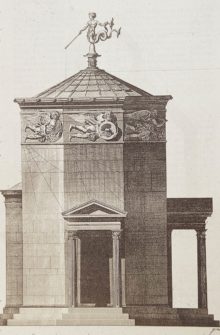 The most remarkable monument representing the winds is the octagonal tower of Andronicus Cyrrhestes at Athens. Each of the eight sides of the monument represents one of the eight principal winds in a flying attitude.
The most remarkable monument representing the winds is the octagonal tower of Andronicus Cyrrhestes at Athens. Each of the eight sides of the monument represents one of the eight principal winds in a flying attitude.
A moveable Triton in the centre of the cupola pointed with his staff to the wind blowing at the time.
All these eight figures have wings at their shoulders, all are clothed, and the peculiarities of the winds are indicated by their bodies and various attributes.
This is how it looks today:
- Names: Eleutheria, Ilithyia, Genetyllis
- Origin: Crete
- Favored People: Midwives
- Attribute: Torch
Eileithyia is the ancient goddess of childbirth, midwifery, and birthing pains. Eleithyia’s name translates as “Fluid of Generation,” giving her strong fertile aspects, and she also has a hand in personal fate.
According to myth, Eleithyia was the midwife of the gods and even birthed Eos, the creative force behind all things. When Eleithyia’s hands were closed, birth was delayed. When Eleithyia opened her body, a child arrived effortlessly.
Eileithyia is believed to be a Minoan goddess assimilated into the Greek pantheon as Hera’s daughter. She works very closely with Hera and is Hera’s weapon in her struggle to prevent Zeus’ other wives from giving birth and threatening the sovereignty and status of her own children. Without Eileithyia’s cooperation, labor cannot go well and perhaps cannot occur at all.
Eileithyia was venerated by pregnant women and those in labor to provide safety success and to lessen pain. Although comparatively little attention is paid to her in mythology books, she was actually subject of great popular veneration. She had many shrines and was considered an extremely significant deity.
Iconography: A woman bearing a torch or with hands upraised, as if beckoning. Sometimes there is one Eileithyia, but sometimes she is portrayed as a pair of spirits.
Sacred site: The cave of Eileithyia near Knossis, Crete, is allegedly her birthplace and was an important pilgrimage site. She is associated with caves, in general. Eileithyia was a widely venerated goddess with shrines throughout Greece.
Offerings: Ex-votos (milagros) in the shape of breasts; incense; water
